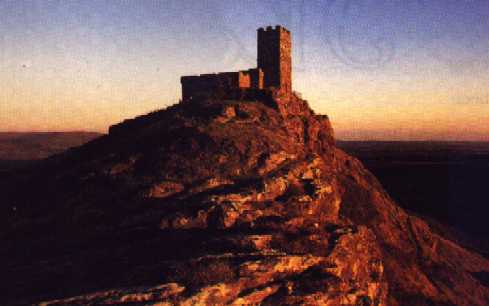|
|
|
On Dartmoor the Devil usually appears with his wisht hounds. A pack of black fiendish dogs hunting the countryside for victims to carry off to Hell. If a lone dog is spotted it is often said to be the spirit of an evil-doing person who is serving a penance. The 'black dog' legends are widespread across the moor and also elsewhere in Devon.
The only people who are safe are those that have never sinned. I should imagine that counts most of us out!
In Devon the Devil is usually known as 'the Evil One.'

The Dewerstone
The Dewerstone, on the southern edge of Dartmoor is supposedly a favourite haunt of the Devil. With his pack of wisht hounds he would drive sinners to the edge of the cliff, never once touching them, where they would then fall onto the jagged rocks below. On a stormy night you can hear the cries of the unfortunates as they relive their nightmarish death. It is best not to linger too long near the Dewerstone for if you see one of the huge black dogs with red eyes then you won't survive.
One morning the imprint of a naked human foot was found at the edge of the Dewerstone with cloven hooves visible behind it.

Whistman's Wood
|
This wood is one of the last remaining areas of ancient woodland and from a distance looks like scrubland. As you get closer you see that the trees are short and stunted, twisted into weird shapes with an average height of just 10ft. around the base of the trees are large granite boulders. Although the trunks and branches are covered with lichen and moss they are healthy, and are actually growing. |
These woods are the home of the Wisht pack and they hunt their victims from the slopes nearby and force them deeper into the wood. Lost and trapped they would fall over the boulders and break a leg. The hounds simply wait, closing in on their prey in silent shuffles. By the time their evil fangs sink into the flesh, the victim is mercifully insane from the horror of what is to befall him.

Branscombe's Loaf
A group of stones on Corn Ridge, Sourton Common, are known as Branscombe's Loaf and Cheese, the story being that a 13th century Bishop of Exeter was riding home one summer's evening with a servant, when they met a man on the moor. He offered them refreshments in the form of a round loaf and a lump of cheese. As the bishop was about to take a bite the servant knocked it from his hand because he had seen the stranger's cloven hoof peeping out from beneath his long cloak. If the bishop had eaten then he would have been in the Devil's power, as it was the loaf and cheese were changed into huge rounded granite boulders and the Devil disappeared.

The Devil's Stone
This stone at Shebbear has several connections with the Devil. In one story he is buried underneath it, in another he dropped it whilst fleeing from heaven after being thrown out.
A strange custom is performed annually on 5th November when bell-ringers using crowbars turn the 1 ton stone over. This is done to keep the Devil away for another year. One year during WW1 this wasn't done and the village had a lot of bad luck. The church bells are rung before the ritual to keep evil spirits at bay.
![]()
The devil enjoyed playing quoits and one day he challenged King Arthur to a match. They stood on facing hills, hurling quoits to and fro. The king won and the Devil didn't take losing too well. He turned the quoits to stone and today they are the rocks that crown the tors.
![]()
Dunkery Hill, the highest point on Exmoor, is made of rock and soil that the Devil dumped there while he was digging the large hill on Winsford Hill, known as the Punchbowl.
![]()
Brentor Church

The church of St. Michael of the Rock is at the top of Brentor and it's position has been attributed to the Devil. It seems that while the church was being built the Devil kept stealing all the foundation stones. However an Archangel, St. Michael, took a dim view of this and hid behind Cox Tor, a mass of rocks fives miles to the south east. When the Devil turned up to vandalize the builders efforts, the Archangel threw a massive rock at him. This hit him right between the horns and he gave up, allowing the church to be completed.
Another version has it that the Devil decided to fustrate the builders of the church by moving the stones to the top of the Tor. After doing this for a few weeks the builders chose to build the church there instead.